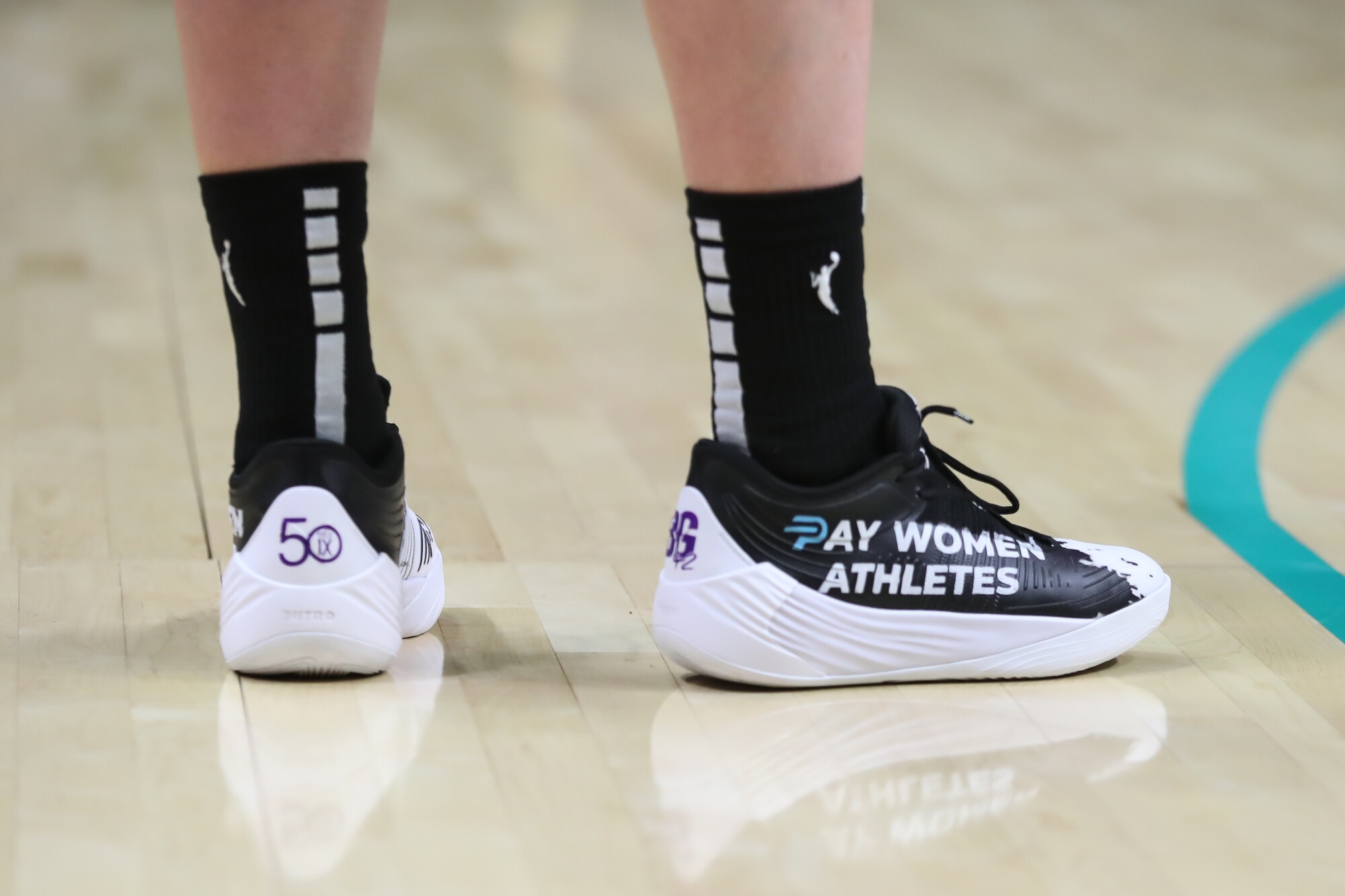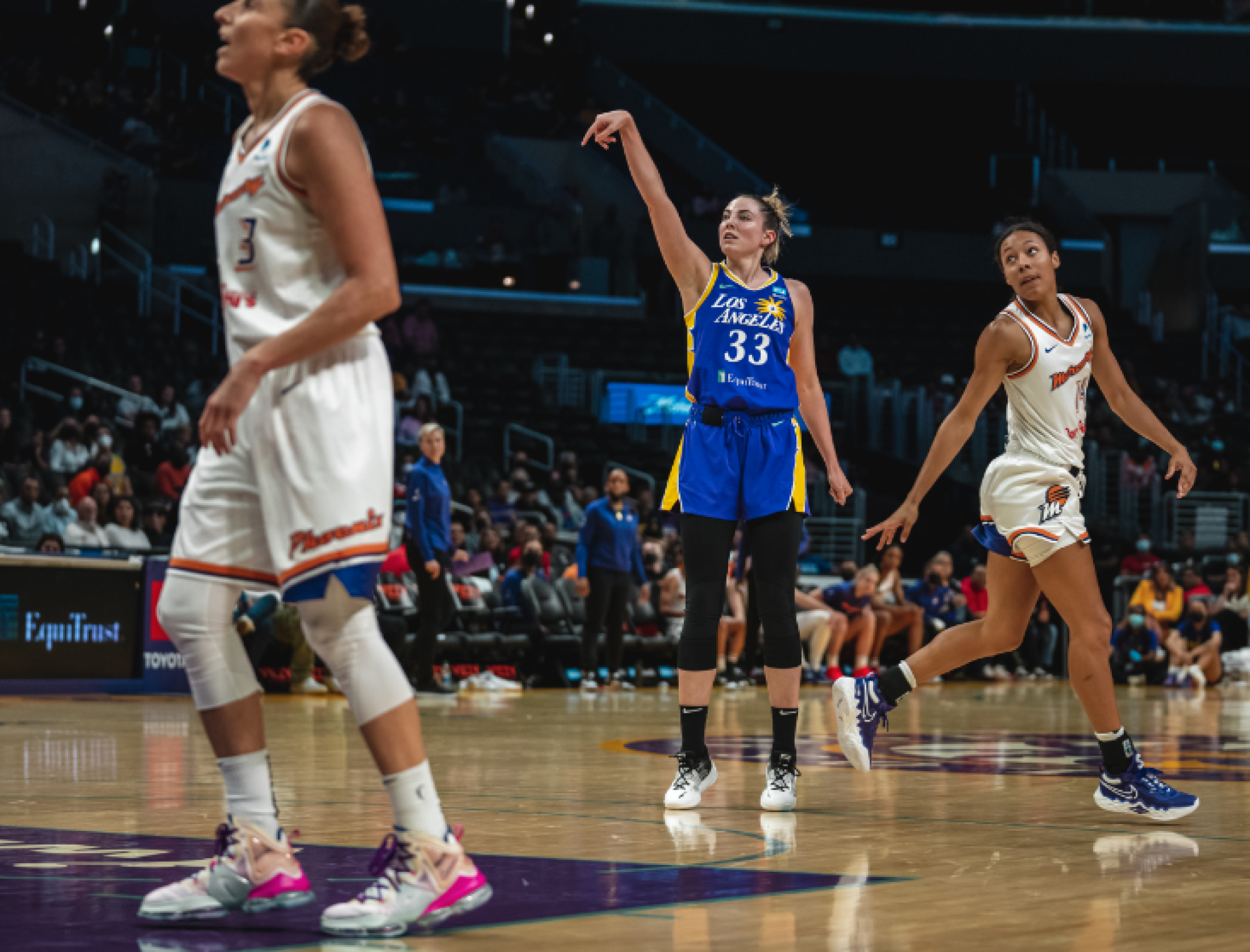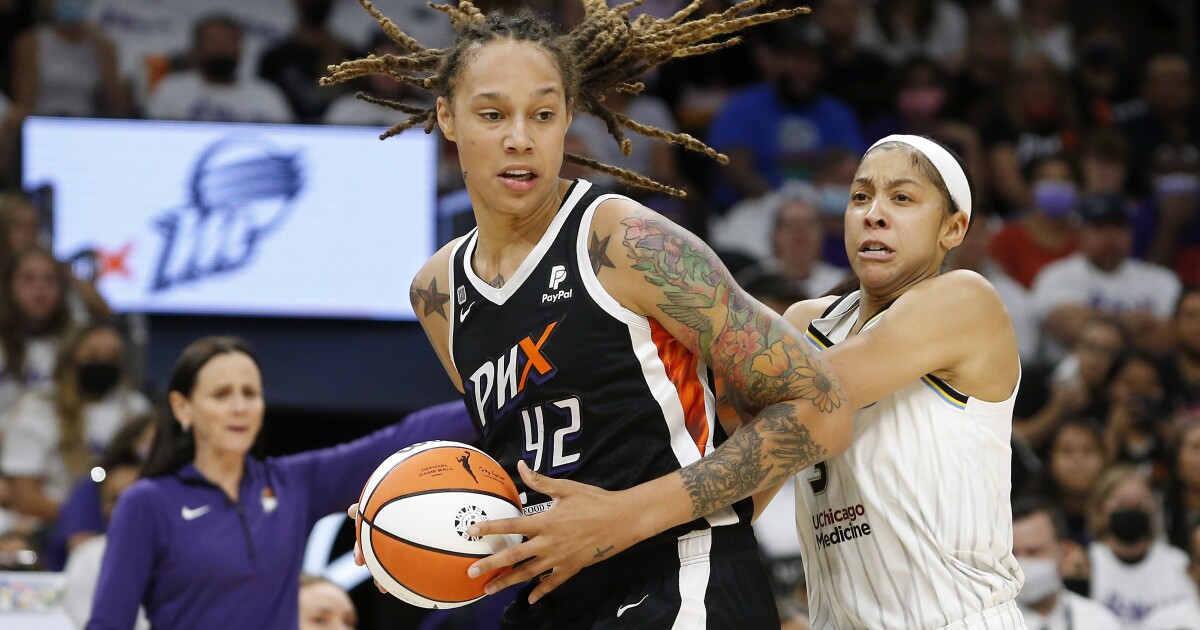Pay equity in women’s sports: How the WNBA is playing the long game
Katie Lou Samuelson had the perfect shoes to mark the anniversary of Title IX. Before the Sparks’ home game against the Chicago Sky on June 23, Samuelson unwrapped white tissue paper in a black shoe box to reveal her custom-decorated pair of Puma sneakers.
“Pay women athletes,” Samuelson’s shoes proclaimed in a bold white font across a black background.
The sneakers included a mark for the anniversary of Title IX on the back of the left shoe and Brittney Griner’s initials and jersey No. 42 on the right.
The Phoenix Mercury center’s detainment and conviction in Russia for cannabis possession has become a symbol of the pay-equity issue plaguing the WNBA, where even stars like Griner — a WNBA champion, two-time Olympic gold medalist and eight-time All-Star — travel overseas during their WNBA offseason for salaries worth more than four or five times what they earn at home.
International leagues, established decades before 26-year-old WNBA, have long been financial lifelines for American players who spend five months in front of home-country crowds then jet off for seven-month seasons in Turkey, Spain, Russia, China or Australia.
The exotic locations and massive paydays come at the expense of attending major events like weddings and birthdays or spending time with loved ones, not to mention additional wear and tear on a player’s body.

A look at the basketball shoes of Sparks forward Katie Lou Samuelson with “Pay Women Athletes” in writing.
(Icon Sportswire / Icon Sportswire via Getty Images)
Samuelson, who also plays in Spain, can picture a future for the WNBA when players aren’t as compelled to play overseas, but it’s a long way off. The WNBA regular season probably would have to be longer than four or five months. Rosters would need to expand from 12 players. Salaries would have to rise.
The steps to shrink the pay gap start with growing the WNBA, a responsibility shared by the league, players and agents.
“As women in sports, we have to play the long game,” said Allison Galer, an agent who represents the Sparks’ Chiney Ogwumike, Washington forward Elizabeth Williams and reigning rookie of the year Michaela Onyenwere.
Rising TV ratings and merchandise sales indicate the WNBA is climbing in popularity. It is a recent boom, finding its origin in Bradenton, Fla., where the WNBA held its pandemic bubble season in 2020. The disastrous year had a silver lining for the WNBA. Viewership for the WNBA Finals grew 15% from the previous year when almost all other leagues were experiencing significant viewership decline. Off the court, unapologetic advocacy from players for Breonna Taylor, Black Lives Matter and voting rights bolstered the WNBA’s image as a leader in social justice.
Many companies are championing diversity, equity and inclusion in the wake of 2020, which should make the WNBA and its players prime targets for endorsement deals from brands looking to connect with younger, digital-savvy and predominantly female customers.
“We’re the league that [says] put your money where your mouth is,” WNBA commissioner Cathy Engelbert said.

Cathy Engelbert, addressing the media during the 2020 WNBA Finals, became the league commissioner in 2019 with an eye toward making the league a thriving business.
(Associated Press)
A commonly repeated statistic from Women in Sport says only 0.4% of total sports sponsorship between 2011 and 2013 went to women. That tiny sliver is typically dominated by athletes who star in individual sports.
Naomi Osaka and Serena Williams were the only female athletes in Forbes’ top 50 this year with the 24-year-old Osaka checking in as the highest-paid female athlete in the world. Her estimated total earnings of $59.2 million ranked 19th overall, and $58 million came from off-court deals. Williams earned $45 million of her $45.3 million off the court and ranked 31st.
The top-earning female athlete has been a tennis player in every year since Forbes started tracking the data in 1990, reinforcing an ecosystem that undervalues women in team sports, Engelbert said.
“Before I’m done,” she added, “we’re going to change the broken valuation model.”
The WNBA is valued at more than $1 billion, a spike due to a recent $75 million capital raise. The cash from two dozen investors was the largest-ever capital raise for a women’s sports property.
The money will be deployed over three to five years, Engelbert said. It’s earmarked for brand elevation and marketing; globalization of the WNBA; innovation and growth of consumer touchpoints; and human capital and operational optimization, according to a statement from the league announcing the transaction.
Where it won’t go is to player salaries.
Although the 2020 collective bargaining agreement secured several benefits like six-figure salaries on average, higher pay for star players and fully paid maternity leave, players have yet to secure equal revenue sharing.
WNBA players are guaranteed only a 50-50 split of revenue if the league meets prescribed but undisclosed goals. The WNBA had an estimated $60 million in revenue in 2018, according to Forbes. The NBA, 50 years older, raked in $7.4 billion that year and boasted $10 billion in revenue this year.
The dual tasks of growing revenue and amending the CBA, which runs through 2027, makes it unlikely that increasing player salaries will be the next domino to fall in the WNBA’s pay-equity fight.
“Everyone wants to go straight to the salary,” said Samuelson, a former No. 4 overall pick who has played on four teams in her four years in the WNBA. “But there are so many different things that need to be stepping stones before that happens too.”
Apart from increased pay, players point to issues such as the lack of charter flights — especially during this compressed season that has teams often playing games every other day — or practice facilities. The Sparks have split their practice time between three venues this season: a gym rental in Torrance, USC’s Galen Center and at Crypto.com Arena, where they also play games.

Sparks forward Katie Lou Samuelson follows through on a three-point shot during a game against the Phoenix Mercury.
(Courtesy of LA Sparks)
Top overseas leagues meet those off-court demands. Not only do players get paid well, but they play among elite competition while honing their skills. Opportunity for development is especially important for younger players who get limited playing time in the WNBA, which has no practice squads or developmental league. The richest teams, including Griner’s UMMC Ekaterinburg that is controlled by a pair of Russian oligarchs, are known to set players up with their own apartments, private car services and luxury travel accommodations.
But the opportunities to play overseas are dwindling, Galer said. She doesn’t think any agent will send an American player to Russia in light of Griner’s detention, the war in Ukraine and the Euroleague’s suspension of the top Russian teams UMMC Ekaterinburg, Dynamo Kursk and MBA Moscow. COVID-19 also crippled the overseas market.
With WNBA salaries stagnating, “there’s a lot more weight on sponsorships and brand partnerships,” Sparks forward Nneka Ogwumike said.
Recreating the sponsorship blueprint for WNBA players requires hustle and intentional brand-building efforts from individual player agents and the league. From her first day as commissioner in 2019, Engelbert said the WNBA had a “marketing issue.” To help solve it, she has tried to encourage players to stay in the United States during the offseason in exchange for league marketing agreements that provide compensation for participating in ad campaigns with WNBA partners.
The hope is to turn players such as reigning league most valuable player Jonquel Jones and WNBA Finals MVP Kahleah Copper into household names. But those stars played overseas last year, with Jones playing for Russia’s UMMC Ekaterinburg, the same club as Griner. Copper was named MVP for the top Spanish league and the Euroleague.
The marketing money offered by the WNBA can’t yet make up the difference of an overseas contract that pays between $10,000-$15,000 a month.
“Is it better for players to be here for marketability purposes? Of course,” Galer said. “But the pot doesn’t necessarily get bigger for every player if they’re staying here.”
Engelbert said she would never shut down overseas opportunities for players but wanted them to prioritize the WNBA and for the league to make it financially worthwhile to do so. Standing behind a podium on All-Star weekend, Engelbert celebrated the progress made in the latter.
During a news conference in Chicago at the league’s marquee midseason event, the commissioner announced an additional $1.5 million would be available to players from the league’s marketing agreement pool. Charter flights for the WNBA Finals were on the way. The playoff bonus pool increased by roughly 50% to $500,000.
“We’re just trying to chip away,” she said at the event.
Engelbert repeated the phrase when describing the WNBA’s journey toward pay equity. No one can simply solve the issue with a sweeping declaration, but the recent progress has the commissioner, players and agents looking toward a bright future
Nneka Ogwumike said she’s hopeful “it won’t take much longer to see minimum salaries be six figures.”
And Engelbert is already scouting cities for potential expansion teams launching in 2024 or 2025.
“We’re only going up from here,” Galer said. “We just have to build it.”
For all the latest Sports News Click Here
For the latest news and updates, follow us on Google News.

